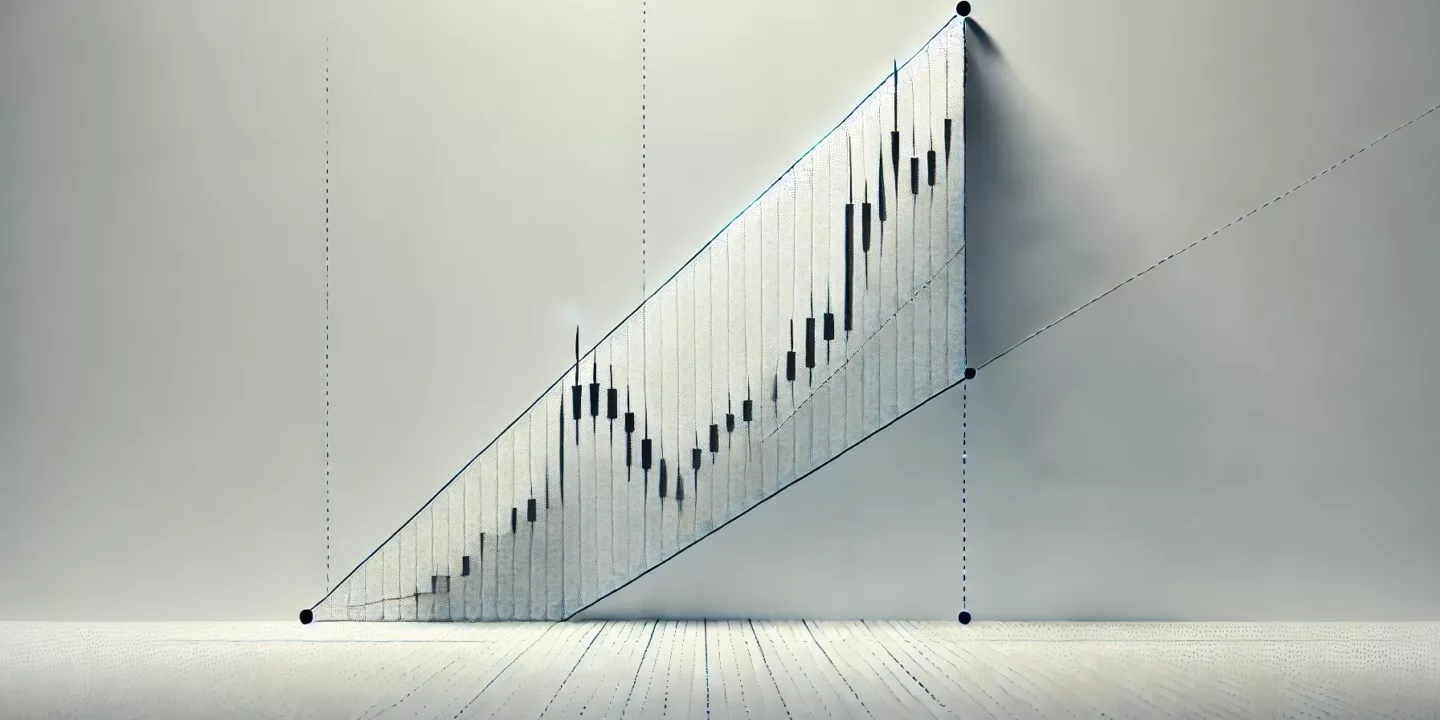Cryptocurrency trading can be difficult to grasp, especially with the market’s unpredictable nature. Traders use various technical analysis tools to make things easier, and one of these tools is the rising wedge pattern. In this article, we will learn what the rising wedge pattern in crypto trading is, how to identify it, and how you can use it to get better results in future trades.
Key Takeaways
- What is a Rising Wedge Pattern?
- Steps to Trade the Rising Wedge Pattern in crypto
- Advantages and Limitations of the Rising Wedge Pattern
What is a Rising Wedge Pattern?
The rising wedge pattern is a bearish technical analysis formation that suggests a trend reversal. It comprises two trendlines, one connecting higher lows and the other higher highs.
The joining of the two lines indicates a reduction in the rising momentum. Over time, this pattern develops, showing a decline in price movement and a sign that buyers are becoming weaker in volumes.
A rising wedge pattern is formed when prices rise to higher highs and higher lows, but the strength in the highs is lesser than that in the lows. This pattern forms at the intersection of the two trendlines and can be identified in various timeframes.
Why Use the Rising Wedge Pattern?
Traders use the rising wedge pattern because it helps identify potential reversal points in the market. This pattern is extremely valuable in predicting bearish reversals, allowing traders to prepare for potential price falls.
By recognizing this pattern, you can make more informed decisions about when to enter or exit trades.
The rising wedge pattern is not just about predicting price declines but also helps understand the market’s sentiment.
When you see this pattern, it suggests that the bullish momentum is weakening, and the bears are gradually gaining control. This shift in momentum helps you make informed trading decisions.
How to Spot and Identify a Rising Wedge Pattern in Crypto
Identifying a rising wedge pattern in crypto trading involves looking for the following characteristics:
Upward Sloping Trendlines
The pattern is defined by two converging trendlines that slope upwards. The upper trendline connects higher highs, while the lower trendline connects higher lows. The converging nature of these lines indicates that the price is moving within a narrowing range.
Volume Confirmation
The trading volume declines as the pattern develops, indicating weakening buying pressure. This reduction in volume suggests that fewer traders are willing to buy at higher prices, adding to the bearish sentiment.
Breakdown Point
The pattern is confirmed when the price breaks below the lower trendline, often accompanied by an increase in volume. This breakdown signals that the strength of the bears is beating that of the bulls, leading to a potential reversal.
Steps to Trade the Rising Wedge Pattern in crypto
Here is a detailed process to use the rising wedge pattern in crypto trading strategy:
Step 1 – Identify the Pattern
First, you should spot the rising wedge pattern on your chart and ensure that the trendlines are converging, with higher highs and higher lows forming the structure. You can use various charting tools to draw these trendlines accurately. Look for patterns in different timeframes to understand market trends.
Step 2 – Confirm with Volume
Look for decreasing volume as the pattern develops. Confirming the volume changes is extremely important as it indicates weakening buying pressure, supporting the likelihood of a bearish reversal. Use volume indicators to assess the strength of the pattern. A rising wedge pattern with declining volume strongly signals an impending bearish move.
Step 3 – Wait for the Breakdown
The pattern is not complete until the price breaks below the lower trendline. Wait for this breakdown before taking any action. An increase in volume during the breakdown adds strength to the signal. Remember to be patient, as prematurely entering into a trade can lead to false signals and potential losses.
Step 4 – Enter the Trade
After the breakdown is confirmed, enter a short position and place an SL order just above the upper trendline to manage your risks. To maximize potential gains, make sure that your entry point is as close to the breakdown level as possible. Use limit orders to achieve precise entries.
Step 5 – Set Profit Targets
Determine your profit targets by identifying key support levels below the breakdown point. These levels can act as potential areas where the price might reverse again. You should keep adjusting your targets based on the overall market conditions and the strength of the pattern, and remember to use trailing stops to lock in profits as the price moves in your favor.
Trading Strategies Using the Rising Wedge Pattern in crypto
Using the rising wedge pattern involves various strategies to help you make informed trading decisions. Here are some effective strategies:
Short Selling
Short selling is an old trading strategy that involves borrowing a cryptocurrency, selling it at the current market price, and then buying it back at a lower price to settle your initial borrowings.
When you take a short position in a cryptocurrency, you expect to earn profits by predicting the market’s downfall. When you identify a rising wedge pattern, it signals a potential price decline, making it an ideal time to consider short selling.
Combining with Oscillator Indicators
Combining the rising wedge pattern with oscillator indicators like the Relative Strength Index (RSI) or the Moving Average Convergence Divergence (MACD) can enhance your trading strategy. For example, if the RSI shows overbought conditions while the rising wedge pattern forms, it will help you gain a stronger conviction in your bearish predictions for the cryptocurrency.
Options Trading
Options trading allows you to hedge against potential losses. For instance, you can buy put options to protect your existing long positions if you identify a rising wedge pattern that signals a potential reversal. By doing this, if the price of the cryptocurrency does decline, your losses on the long position can be offset by gains on the put options.
Understand options trading basics, including strike prices, expiration dates, and premiums. You should properly calculate your risks and rewards before going into trades.
Monitoring for Divergences
Monitoring divergences between the price and oscillator indicators can enhance your trading strategy. If the price forms a rising wedge pattern while an oscillator shows bearish divergence, it can provide additional confirmation for a potential reversal. This added layer of analysis can improve the accuracy of your trades. Use divergence signals to fine-tune your entry and exit points.
Advanced Techniques for Using the Rising Wedge Pattern
For experienced traders, advanced techniques can further increase the usefulness of the rising wedge pattern:
Multi-Timeframe Analysis
Analyze the rising wedge pattern across multiple timeframes to get a good grasp of the market’s sentiment. For example, identify the pattern on a daily chart and confirm it on a weekly chart for stronger signals.
Combining with Fibonacci Retracement
Use Fibonacci retracement levels to identify reversal points within the rising wedge pattern. Combining these levels with the pattern can provide more precise entry and exit points.
Harmonic Patterns
Integrate harmonic patterns like the Gartley or Butterfly pattern with the rising wedge to identify high-probability reversal zones. Harmonic patterns use Fibonacci ratios to predict potential price movements.
Volume Spread Analysis (VSA)
Use VSA to analyze the relationship between price movements and volume. VSA can provide a deep understanding of the strength of the rising wedge pattern and the likelihood of a breakdown.
Algorithmic Trading
Develop algorithmic trading strategies that incorporate the rising wedge pattern. Use programming languages like Python or trading platforms like MetaTrader to create automated trading systems based on the pattern.
Advantages and Limitations of the Rising Wedge Pattern
Advantages
The rising wedge pattern offers several advantages to traders:
Early Reversal Signal
The pattern provides an early signal of a potential bearish reversal, allowing you to prepare for a price decline. This early warning can be crucial for managing risk and optimizing trade entries.
Volume Confirmation
The pattern’s reliance on volume confirmation adds credibility to the reversal signal. Decreasing volume during the pattern formation and increasing volume during the breakdown enhance the reliability of the signal.
Versatile Timeframes
The rising wedge pattern can be used across various timeframes. This makes it versatile and applicable for strategies with different lengths of time. Adapt the pattern to different market conditions and trading styles.
Clear Entry and Exit Points
The pattern offers clear entry and exit points, helping you make more precise trading decisions. Use the trendlines and volume signals to determine optimal trade levels.
Limitations
While the rising wedge pattern is a powerful tool, it has its limitations:
False Breakdowns
The pattern can produce false breakdowns, leading to potential losses if not confirmed with volume and other indicators. Always wait for volume confirmation and use additional indicators to validate the signal.
Complex Identification
Identifying the pattern accurately can be challenging, especially for novice traders. Practice drawing trendlines and recognizing patterns to improve your identification skills.
Market Conditions
Overall, market conditions and external factors, such as news events or market sentiment, can influence the pattern’s effectiveness. Stay informed about market news and trends to understand the pattern’s context.
Common Mistakes to Avoid When Using the Rising Wedge Pattern
Understanding the common mistakes traders make when using the rising wedge pattern can help you avoid pitfalls and improve your trading performance:
Entering Trades Prematurely
One common mistake is entering a trade before the breakdown is confirmed. Ensure the price breaks below the lower trendline with increased volume before entering a position. Patience is key to avoiding false signals.
Ignoring Volume Confirmation
Failing to consider volume can lead to incorrect interpretations of the pattern. Decreasing volume during the pattern formation and increasing volume during the breakdown is very helpful for validating the signal.
Setting Inappropriate Stop-Loss Orders
Placing stop-loss orders too close to the entry point can result in premature exits due to normal market fluctuations. Ensure that your stop-loss levels account for potential market volatility and are placed strategically above the upper trendline.
Overtrading
Overtrading occurs when traders take too many positions based on the pattern without considering the overall market context. Avoid overtrading by being selective and ensuring each trade aligns with your overall strategy.
Neglecting Other Indicators
Relying solely on the rising wedge pattern without considering other technical indicators can lead to incomplete analysis. To confirm your trading decisions, use additional indicators like moving averages, RSI, MACD, and support/resistance levels.
Conclusion
The rising wedge pattern is a useful tool for you as a crypto trader as it helps in identifying profitable trading opportunities. By understanding how this pattern works and using it effectively, you can enhance your trading strategies and improve your chances of success.
Remember, while the rising wedge pattern can provide significant advantages, it should not be relied upon solely. Combining it with other technical analysis tools and considering overall market conditions will lead to more informed and effective trading decisions.
With complete knowledge of the rising wedge pattern, are you ready to begin trading in crypto assets? Mudrex is a reliable cryptocurrency platform that helps you trade seamlessly to make gains. Download the app now to start crypto trading right away!
FAQs
What is the significance of volume in the rising wedge pattern?
Volume plays a crucial role in validating the rising wedge pattern. Decreasing volume during the formation indicates weakening buying pressure, while a significant increase in volume during the breakdown confirms the bearish signal, making the pattern more reliable.
Can the rising wedge pattern be used in all timeframes?
Yes, the pattern can be applied to various timeframes, from hourly charts for short-term trades to daily or weekly charts for long-term investments. The pattern’s principles remain consistent across different timeframes, but the significance of the signal varies.
How do I set effective stop-loss orders when trading the rising wedge pattern?
Effective stop-loss orders should be placed just above the upper trendline of the rising wedge pattern. This placement helps protect against false breakouts and market volatility while ensuring that your risk is managed appropriately.
Is the rising wedge pattern always bearish?
While the rising wedge pattern is usually considered bearish, indicating a potential reversal to a downward trend, it is important to confirm the pattern with volume and other technical indicators to ensure its reliability before making trading decisions.







